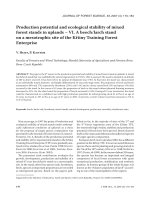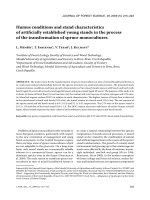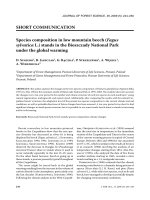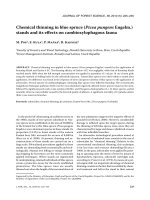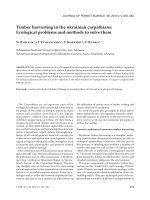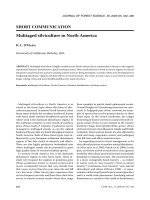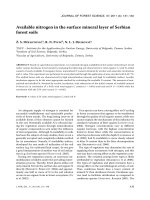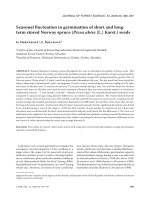Báo cáo lâm nghiệp: "Nutrient dynamics in decomposing needles of Pinus luchuensis after typhoon disturbance in a subtropical environment" pps
Bạn đang xem bản rút gọn của tài liệu. Xem và tải ngay bản đầy đủ của tài liệu tại đây (375.75 KB, 7 trang )
Ann. For. Sci. 63 (2006) 707–713 707
c
INRA, EDP Sciences, 2006
DOI: 10.1051/forest:2006051
Original article
Nutrient dynamics in decomposing needles of Pinus luchuensis after
typhoon disturbance in a subtropical environment
Xiaoniu X
a,b
*
a
Department of Forest Science, College of Forestry and Landscape Architecture, Anhui Agricultural University, Hefei, Anhui 230036, PR China
b
Field Science Center for Northern Biosphere, Hokkaido University, Nayoro, Hokkaido 096-0071, Japan
(Received 24 July 2005; accepted 17 January 2006)
Abstract – Decomposition of typhoon-generated and normally fallen needles and their dynamical patterns of nutrient release for ten elements (C, N,
P, K, Ca, Mg, S, Fe, Al, and Mn) were investigated over 3 yr using the litterbag technique in a subtropical pine plantation (Pinus luchuensis Mayr.) in
Okinawa, southwestern Japan. After 3 yr, decomposition rates (k values) were 0.361 and 0.323 yr
−1
, respectively, for typhoon-generated and normally
fallen needles. The typhoon-generated needles decomposed significantly more rapidly than the normally fallen needles did, which was due to the higher
N and P concentrations. Nutrient transfer patterns for elements varied greatly. However, significant differences in mass dynamic patterns of elements
between typhoon-generated and normally fallen needles were found only in N and P (P < 0.001). Nutrient mobilities during the decomposition
processes were similar in both typhoon-generated and normally fallen needles and was ordered as follows: K > Ca ≥ Mg ≥ C > S ≥ N ≥ Mn > P Fe
≥ Al. Rapid decomposition with rapid release of P and N in typhoon-generated needles indicates that typhoon disturbances can drive P and N cycling
at a somewhat higher rates, which is more important from the standpoint of forest productivity since P and N are limiting nutrients in the subtropical
forests in Okinawa.
litter chemical quality / needle decomposition / nutrient release / pine plantation / Pinus luchuensis / typhoon impact
Résumé – Dynamiques des nutriments dans les aiguilles en décomposition de Pinus luchensis après les perturbations liées à un typhon dans
un environnement subtropical. La décomposition des chutes d’aiguilles normales et occasionnées par un typhon et leur modèle de libération des
nutriments ont été étudiés pour 10 éléments (C, N, P, K, Ca, Mg, S, Fe, Al et Mn). L’étude a été faite dans une plantation de pin (Pinus luchensis
Mayr.) à Okinawa (SO du Japon). Elle a duré 3 ans et a utilisé la technique des bacs à litière. Après 3 ans les taux de décomposition étaient de 0,361
et 0,323 an
−1
respectivement pour les chutes d’aiguilles liées au typhon et les chutes normales d’aiguilles. Les chutes aiguilles liées au typhon se
décomposent significativement plus rapidement que les chutes normales d’aiguilles, ce qui est du à une plus forte concentration en N et P. Les modèles
de transfert des éléments varient fortement. Toutefois, des différences significatives dans les modèles de dynamique de masse des éléments entre les
deux types de chute d’aiguille ont seulement été mises en évidence pour N et P (P < 0,001). La mobilité des éléments pendant les processus de
décomposition étaient similaires dans les deux types de chute d’aiguilles et s’ordonnait de la façon suivante : K > Ca ≥ Mg ≥ C > S ≥ N ≥ Mn > P
Fe ≥ Al. Une décomposition rapide avec une libération rapide de P et N pour les aiguilles dont la chute a été occasionnée par le typhon indique que la
perturbation par le typhon peut conduire le cycle de P et N à un taux quelque peu plus rapide, ce qui est important du point de vue de la productivité de
la forêt puisque P et N sont des nutriments limitants dans les forêts subtropicales d’Okinawa.
qualité chimique de la litière / décomposition des aiguilles / libération des nut riments / plantation de pin / Pinus luchensis / typhon impact
1. INTRODUCTION
Pine forests are widely distributed from boreal to tropi-
cal regions of East Asia. In Japan, the secondary pine forests
are composed of Japanese red pine (Pinus densiflora Sieb. et
Zucc.), Japanese black pine (P. thunbergii Parl.), and Luchu
pine (P. luchuensis Mayr.). P. densiflora is distributed on the
Osumi Islands, Kyushu, Shikoku, Honshu and the southern
part of Hokkaido Island; P. thunbergii is distributed on the
Tokara Islands and northward except for Hokkaido Island [34].
The distribution of P. luchuensis is limited to the Ryukyu Is-
lands, southwestern Japan [14]. Luchu pine was introduced to
the Bonin Islands and some national forests in Kyushu, and
was also introduced to Taiwan [39]. In Okinawa, Luchu pine
* Corresponding author:
is one of the most important tree species for timber production,
and covers about 62% of the total forest plantations. The ma-
jority of Luchu pine plantations were established during 1950s
and 1960s [39].
In the forest ecosystems, litterfall represents a major bio-
logical pathway for nutrient transfer from vegetation to soils.
However, nutrient availability for plant growth is mainly deter-
mined by decomposition rate [29]. Decomposition processes
are, therefore, an important part of the nutrient cycling. A
thorough understanding of this process is essential in under-
standing the structure and functioning of terrestrial ecosys-
tems. For this reason, a large number of studies have inves-
tigated the decomposition of plant litter from a wide range of
species and the biotic and abiotic factors regulating this pro-
cess [1,9, 15]. On the other hand, typhoon disturbances have a
significant impact on the annual litter production [27, 36, 38].
Article published by EDP Sciences and available at or />708 X. Xu
Typhoons occur frequently in Okinawa. During 1996–2000,
typhoon occurred 15 times (maximum wind velocity over
15 m s
−1
). Fine litterfall generated by typhoons ranged from
1.21 to 4.32 Mg ha
−1
yr
−1
in subtropical evergreen forest
[38]andfrom2.21to5.12Mgha
−1
yr
−1
in pine plantations
[36]. Litter resulting from typhoon is usually composed of
lot of green leaves and twigs. Green leaves are rich in nutri-
ents and soluble organic C fractions, and is, therefore, quali-
tatively very different from the normally fallen litter materials
[11, 16, 37]. The addition of a high amount of green leaves
mayalsoaffect the decomposition and nutrient dynamics on
the forest floor. Litter decomposition and nutrient release are
controlled by a combination of factors including litter quality,
the physico-chemical environment, and the nature and activity
of decomposer organisms [3,33]. Although the decomposition
process has frequently been studied in forest ecosystems, data
on the decomposition process in Luchu pine plantation, par-
ticularly on the differences between typhoon-generated nee-
dles and normally fallen ones, are few. The objective of the
present study is to determine the pattern of nutrient release in
decomposing pine needles resulting by typhoon disturbance in
comparison with the normally fallen needles, to improve our
understanding of the impact of typhoon disturbances on nu-
trient cycling processes in a pine plantation in the subtropical
environment. The nomenclature employed in this article fol-
lows that of Hatushima and Amano [14].
2. MATERIALS AND METHODS
2.1. Study site
The study site is located in the Yona Experimental Forest at the
University of the Ryukyus, northern part of Okinawa Island. The lati-
tude and longitude of the site are 26
◦
45
30
N and 128
◦
5
E, respec-
tively. The area is characterized by a subtropical climate and abun-
dant rainfall throughout the year. Annual mean temperature is about
21.8
◦
C. Annual mean rainfall is 2680 mm over last 30 years (Ex-
perimental Forest, University of the Ryukyus). Mean annual relative
humidity reaches 82%. Typhoons frequently occur between June and
October. Monsoons, from the south or southwest, bring a rainy season
between spring and early summer, and from the north or northwest
create a relatively dry season in winter.
The experimental plot situated in hilly terrain on a midslope (22
◦
)
facing N 30
◦
W at an altitude of 130 m a.s.l. This Pinus luchuensis
plantation was established in 1951. The detailed description of the
sampling stand was given by Xu and Hirata [36]. The annual mean
fine litterfall in the sampling stand was 12 Mg ha
−1
from 1996 to 1998
[36]. The soil at study site has a clay loam texture, and has devel-
oped from tertiary sandstone, with acid characteristics. Soil pH(H
2
O)
is 4.8. Concentrations of total organic C and total N in the surface
soilhorizonare105and5gkg
−1
, respectively. Available P (Bray
II method) is 29 mg kg
−1
. Exchangeable cations (extracted by 1 N
NH
4
Cl) are: K
+
0.66, Ca
2+
2.13, Mg
2+
1.24 cmol (+)kg
−1
, respec-
tively.
2.2. Litterbag experiment
Needle decomposition studies were carried out using the litterbag
technique [7]. Litter bags (20 cm × 15 cm) were made of 1-mm
polyester mesh. Decomposition rate was measured for two needle
types, i.e. typhoon-generated and normally fallen needles. The two
types of needles were collected with litter traps at the same plot dur-
ing the peak fall in July 1997 (normal) and after a strong typhoon
occurred in August 1997 (typhoon-generated), respectively. The nee-
dles collected were oven dried at 70
◦
C, then sealed in polythene bags
and preserved below 15
◦
C in the laboratory. Before the experiment,
four subsamples from the respective samples were taken to determine
moisture and initial chemical concentrations (Tab. I). The equivalent
of 10 g of dry litter was sealed in each bag. Ninety-six litterbags per
needle type were randomly placed in six blocks on the soil surface at
the study site. The experiment, lasting 3 yr, started on 5 July 1998.
Collections were made every month in the first 6-month period, and
then in 3-month intervals. Six replicate litterbags were sampled at
each time, one in each block. The bagged litter samples collected
were cleaned of soil and other extraneous materials, and oven-dried
within 24 h at 70
◦
C to a constant weight, and then milled for chemi-
cal analysis.
2.3. Chemical analysis
All samples in the present study were analyzed for C, N, P, K, Ca,
Mg, S, Al, Fe, and Mn. The concentrations of total organic carbon
and total nitrogen were determined by dry combustion with a C-N
analyzer (Yanaco, MT-500, Kyoto, Japan). The subsamples of 1.0 g
of the ground samples were digested with HNO
3
-HClO
4
reagent , and
analyzed for the concentrations of P, K, Ca, Mg, S, Al, Fe, and Mn,
by inductively coupled plasma spectrometer (Shimadzu, ICPS-2000,
Kyoto, Japan).
2.4. Statistical analysis
There were six replicates of each needle type and all litterbags
were randomly selected for collection. All data were analyzed by Sta-
tistica [31]. The decomposition rate (k) was calculated from the per-
centage of dry mass remaining (ash free) using an exponential decay
model [23]:
W
t
/W
0
= e
−kt
where W
t
/W
0
is the fraction of initial mass remaining at time t,andt
is the elapsed time (yr) and k is the decomposition constant (yr
−1
). As
suggested by Olson [23], the time required for 50% mass loss and nu-
trient release was calculated as T
1/2
= 0.693/k.Paired-samplet-test
analysis was used to determine differences in mass loss, decompo-
sition constant and substrate chemistry between needle types. In all
analyses, P < 0.05 was the criterion for significant differences.
3. RESULTS
3.1. Initial nutrient concentrations
As expected, there is a marked difference in the initial nu-
trient concentrations between the typhoon-generated and nor-
mally fallen needles (Tab. I). Concentrations of N, P, K, and
Mg were significantly higher in the typhoon-generated nee-
dles than in the normally fallen ones. Aluminium and Mn con-
centrations were greater in the normally fallen needles, while
there were no significant differences in total C, S, Ca and Fe
concentrations between the two needle types.
Nutrient dynamics in decomposing needles 709
Table I. Initial chemical composition (mg g
−1
D.W.) with S.E. in the parentheses (n = 4) in the typhoon-generated and normally fallen needles
of Pinus luchuensis Mayr. in subtropics. Values with the different letters in a column are significant different (t-test; P < 0.05).
Needle type C N P K Ca Mg Al Fe Mn S C:N C:P
Normal fall 517 6.53a 0.143a 1.79a 5.31 1.57a 0.256a 0.133a 0.323a 0.489 79a 3615a
(6.53) (0.19) (0.010) (0.12) (0.37) (0.11) (0.010) (0.011) (0.017) (0.012) (7.3) (92)
Typhoon-generated 513 8.86b 0.237b 3.38b 4.96 1.89b 0.186b 0.113b 0.281b 0.515 58b 2165b
(7.21) (0.21) (0.012) (0.18) (0.45) (0.11) (0.009) (0.010) (0.015) (0.015) (6.6) (59)
Figure 1. Percentage of dry mass remaining for the typhoon-
generated and normally fallen needles of P. luchuensis during a 3-yr
decomposition process in subtropics.
Table II. Mean percent loss in dry mass, decomposition constant (k;
yr
−1
), and half-life time (T
1/2
) for the typhoon-generated and nor-
mally fallen needles of Pinus luchuensis in the subtropics. Standard
errors are in the parentheses (n = 6). Values with the different let-
ters in a column are significantly different between needle types at
P < 0.05.
1 yr decomposition 3 yr decomposition
Needle type Loss (%) k Loss (%) kT
1/2
Normal fall 46.2a 0.564a 70.8a 0.361a 1.92a
(2.14) (0.036) (2.23) (0.009) (0.05)
Typhoon-generated 40.4b 0.47b 66.0b 0.323b 2.15b
(2.37) (0.031) (2.66) (0.016) (0.11)
3.2. Weight loss and decomposition rate
The average dry mass loss from the litterbag is shown in
Figure 1. During the first 6 months of incubation, the dry
mass loss in typhoon-generated needles reached 41%, while
the normal ones 34%. Although there were not high differ-
ences, the average values resulted significantly different. Dry
mass remaining over 3 yr decomposition differed significantly
between the two needle types (F = 4.494; df = 1, 16; P <
0.0001).
Dry mass loss and decomposition constants (k values) af-
ter 3 yr are given in Table II. Significant differences between
needle types were found (P < 0.01). The half-life time for
the typhoon-generated needles was 1.92 yr, which is signifi-
cantly lower than that for the normally fallen needles (2.15 yr;
t = 4.177; df = 6; P = 0.009). This indicates a significant
effect of needles type on decomposition rate.
3.3. Nutrient dynamics
Patterns of nutrient transfer indicate how rapidly elements
are lost from decomposing needles. Nutrient transfer patterns
for elements varied greatly, from a net accumulation to a rapid
loss (Fig. 2). Significant differences in element mass dynamics
between typhoon-generated and normally fallen needles were
found only for N and P (P < 0.001).
3.3.1. Nitrogen and phosphorus
Concentrations of N and P increased with mass loss in both
typhoon-generated and normally fallen needles. However, N
immobilization was not found over the 3-yr decomposition. N
release was significantly greater from typhoon-generated nee-
dles than from the normally fallen ones (Fig. 2A). P immo-
bilization was pronounced in this study. The normally fallen
needles showed a net immobilization of P over 3 yr, while
typhoon-generated needles showed a net immobilization in the
first 2 yr and rapid release afterwards (Fig. 2B).
3.3.2. Carbon and sulphur
Carbon concentration kept almost constant during the de-
composition except for the third year with a slight decrease,
while S concentration increased in the first 2 yr and then de-
creased in both typhoon-generated and normally fallen nee-
dles. The pattern of C mass dynamics was similar to the dry
mass with a progressive decrease (Fig. 2A). However, S mass
dynamics showed a net immobilization in the first 1.5 yr and a
rapid release afterwards (Fig. 2B).
3.3.3. Potassium, magnesium and calcium
The result showed that K and Mg were subject to extensive
leaching from decomposing needles in the initial phase. The
mass dynamical patterns of K and Mg demonstrated a rapid
decrease in the first 3–6 months and after then a slight de-
crease for the two needle types measured (Figs. 2C and 2D).
710 X. Xu
Figure 2. Percentage of mass remaining for different nutrient elements in the typhoon-generated and normally fallen needles of P. luchuensis
during a 3-yr decomposition process in subtropics.
Ca concentration increased slightly in the first 3-month period,
and after then declined progressively. The release of Ca mass
was somewhat rapid in both typhoon-generated and normally
fallen needles in this study (Fig. 2C).
3.3.4. Manganese, aluminium and iron
Concentrations of Al and Fe increased significantly over
3-yr study period for both needle types. Significant accumu-
lations of Al and Fe were found in decomposing pine nee-
dles (Fig. 2E). Mn concentration increased steadily in the first
year of decomposition and decreased slightly after then. Sig-
nificant net accumulation of Mn was observed in first 2 yr
(Fig. 2D). The maximum net immobilization of Mn reached
232 and 210% of the initial mass, respectively, in the typhoon-
generated and normally fallen needles.
3.4. C:N and C:P ratio changes over time
Variations in C:N and C:P ratios of the two needle types
during the 3-yr decomposition were shown in Figure 3. Al-
though the two needle types showed the similar pattern, the
time course was significantly different in C:N and C:P ratios
(Fig. 3). C:N ratio decreased progressively over time, while
C:P ratio decreased rapidly in the first year and lowly after-
wards in decomposition processes.
4. DISCUSSION
4.1. Dry mass loss and decomposition rate
The decomposition rate of the typhoon-generated needles
was significantly higher than that of the normally fallen ones.
Nutrient dynamics in decomposing needles 711
Figure 3. Variation in (A) C:N and (B) C:P ratios of the typhoon-
generated and normally fallen needles of P. luchuensis during a 3-yr
decomposition process in subtropics.
This result was similar to the findings by Whigham et al.
[35] and Xu et al. [37] in studies conducted on Hurricane-
and typhoon-generated litter in tropical and subtropical rain
forests. Rapid decomposition of the typhoon-generated nee-
dles should have contributed to its special features of both
anatomical structure and initial substrate [11, 28, 35]. The
typhoon-generated needles, particularly the green ones, were
usually premature, which should be not as hard as the normally
fallen needles in anatomical structure. Moreover, these needles
showed higher concentrations of nutrients especially N and P,
and had higher labile and lower recalcitrant C fractions [11].
These special features for the typhoon-generated litter tend to
increase the decomposition rate.
After 3 yr decomposition, the decomposition constants
(k) were 0.361 and 0.323 yr
−1
, respectively, for typhoon-
generated and normally fallen needles (Tab. II). The constants
(k) were similar to those reported (0.26–0.42 yr
−1
) previously
in some pine forests [8,13, 24, 30], but were higher than those
(0.13–0.19 yr
−1
) reported for pine forests in Mediterranean cli-
mate [19,22].
4.2. Initial litter quality and nutrient dynamics
Different nutrients in decomposing litter have different
patterns of release and retention over time. Microbial immo-
bilization is a major mechanism [25, 33]. The status of a nu-
trient, whether it is limiting or non-limiting to microbial activ-
ity, determines its release dynamics. The limiting nutrients to
microbial activity would thus be retained resulting in immo-
bilization, whereas those in excess would be released during
decomposition [4]. In addition, nutrient release and turnover
are further influenced by the nature of chemical bonds which
attach the elements to humic substances [26,32].
Results from the present study showed that the concentra-
tions of most elements (N, P, S, Mn, Al, and Fe) increased
as the litter decomposed. In contrast to these nutrients, K,
Ca, and Mg concentrations clearly decreased. However, the
change in absolute amount of an element during decomposi-
tion (net immobilization or the net release) is a function of
both mass loss and change in the relative concentrations of
the element in the residual litter. In the present study, the pat-
terns of mass dynamics varied significantly amongst elements
in decomposition processes. N, C, Mg, Ca, and K showed a de-
crease phase (net release), while Al and Fe showed an increase
phase (net immobilization), and P, S, and Mn demonstrated an
increase-decrease phase (initially net immobilization and then
net release) over the 3-yr decomposition. In general, nutrient
release from litter in the early stage (first 1 to 3 months) is
usually caused by leaching. In the following stages, by com-
paring curves of litter decomposition and nutrient dynamics,
it is possible to observe the release of nutrients due to leach-
ing and to microbial decomposition, respectively. According
to Gosz et al. [12], if a nutrient is lost at a rate equal to or
lower than dry mass loss, it is likely released by decomposi-
tion of organic matter; any nutrient loss at a rate higher than
dry mass loss would result from leaching. The rapid release
of K and Mg in the early phase observed in the present study
could be attributed to the physical removal by leaching. The
release of the other elements might be controlled by biological
and chemical processes [20].
The significant increases in N and P concentrations in
typhoon-generated and normally fallen needles indicated that
they were limiting to decomposer organisms. The significant
positive correlations between mass loss and accumulated N
(R
2
= 0.799 and 0.470 for typhoon and normally fallen nee-
dles) and P (R
2
= 0.567 for normally fallen needles) confirm
this. In the present study, P was retained more strongly than
N indicating that it was probably the most limiting element
to the decomposer community. The immobilization and very
slow release of N and P [20, 24, 37] in decomposing litter
are more important from the standpoint of forest productiv-
ity, since they are the most commonly limiting nutrients [2].
Jorgensen et al. [17] reported for other pine forests that N was
the most slowly release macronutrient with only about 27%
of it released over 8 yrs. In the present study, only about 19%
of N was released and no net P release occurred from nor-
mally fallen needles after 3 yrs. In typhoon-generated needles,
however, about 46% of N and 27% of P were released. Other
studies, such as that of Piatek and Allen [24], N release was
712 X. Xu
similar to our result. They also reported sustained P immo-
bilization throughout 26 months, which may be due to lower
initial P concentration (0.2 g P kg
−1
; similar to this study).
Slow release of Ca was observed during decomposition,
which was similar to the dry mass loss because Ca is a struc-
tural component and thus protected from physical leaching
[10, 12]. Like many previous studies [e.g. 12, 20, 26, 37], Al
and Fe were highly immobilized in decomposition processes.
The accumulation of Al and Fe during decomposition process
may be ascribed to an abiotic formation of highly stable com-
plexes with humic substances [26] or to a biotic accumulation
in decomposer microorganisms [5,32], suggesting that the dy-
namics of Al and Fe release could be controlled by both bi-
ological and chemical processes despite of the addition from
exogenous sources also for these elements.
Release of S and Mn during litter decomposition showed
similar pattern. However, Mn was immobilized more rapidly
in the initial phase and released faster in the late phase than
S did in the present study. This release pattern particularly for
Mn is different from some previous studies [12, 13, 20], which
showed a net release of Mn in decomposition processes. It is
probably due to microbial immobilization and/or addition of
Mn from exogenous sources [21].
After 3 yr decomposition, nutrient mobility (similar in both
typhoon-generated and normally fallen needles) was as fol-
lows: K > Ca ≥ Mg ≥ C > S ≥ N ≥ Mn > P Fe ≥ Al. High
mobility of P and Mn has been noted previously [6,13,18, 40].
The rate of release was higher for the macro-elements (C, N,
K, Ca, Mg, S) than for the micro-elements (Mn, Fe, Al) with
the exception of P which behaved as the microelements.
Typhoon disturbances can return large amounts of plant ma-
terial into the forest floor [36, 38]. Those litterfall, particularly
the green ones had higher nutrient concentrations than the nor-
mal litter for those nutrients that are translocated during senes-
cence. On the other hand, the results from the present study
showed that needle litter resulting from typhoon disturbances
decomposed more rapidly than did the normally fallen nee-
dles, with a rapid release of P and N. This leads to increases
in the P and N availability in soil after typhoons. Therefore,
typhoon disturbances redirect nutrient elements (especially N
and P that are usually bound up in wood) into a more mobile
form, cycling them at somewhat higher rates. To a certain ex-
tent, the rapid cycling of N and P driven by typhoons appears
to be an important mechanism to maintain forest productivity
in this subtropical environment.
Acknowledgements: This study was made possible by partial sup-
port from the Japanese Ministry of Education, Sciences, Sports
and Culture. The author gratefully acknowledges the Subtropical
Field Scientific Center of Education and Research, University of the
Ryukyus, for permission to work, and Prof. E. Hirata for invaluable
suggestions. M. Asato helped with laboratory analysis. The sugges-
tions of Dr. G. Aussenac, and two anonymous referees improved the
manuscript substantially.
REFERENCES
[1] Aerts R., Climate, leaf litter chemistry and leaf litter decomposition
in terrestrial ecosystems: a triangular relationship, Oikos 79 (1997)
439–449.
[2] Allen H.L., Dougherty P.M., Campbell R.G., Manipulation of water
and nutrient – practice and opportunity in southern US pine forests,
For. Ecol. Manage. 30 (1990) 437–453.
[3] Berg B., McClaugherty C., Plant litter: decomposition, humus for-
mation, carbon sequestration, Springer-Verlag, Berlin, 2003, 267 p.
[4] Berg B., Staaf H., Leaching accumulation and release of nitrogen in
decomposing forest litter, Ecol. Bull. 33 (1981) 163–178.
[5] Berg B., Ekbohm G., Söderström B., Staaf H., Reduction of decom-
position rates of Scots pine needle litter due to heavy metal pollu-
tion, Water Air Soil Pollut. 59 (1991) 165–177.
[6] Bockheim J.G., Jepsen E.A., Heisey D.M., Nutrient dynamics of
decomposing leaf litter of four tree species on soil in northern
Wisconsin, Can. J. For. Res. 21 (1991) 803–812.
[7] Bocock K.L., Gilbert O.J., Capstick C.K., Turner D.C., Ward J.S.,
Woodman M.J., Changes in leaf litter when placed on the surface of
soil with contrasting humus types, J. Soil Sci. 11 (1960) 1–9.
[8] Brown S., Lenart M., Mo J.M., Kong G.H., Structure and organic
matter dynamics of a human-impacted pine forest in a MAB reserve
of subtropical China, Biotropica 27 (1995) 276–289.
[9] Coûteaux M.M., Bottner P., Berg B., Litter decomposition, climate
and litter quality, Trends Ecol. Evol. 10 (1995) 63–66.
[10] Edmonds R.L., Thomas T.B., Decomposition and nutrient release
from green needles of western hemlock and Pacific silver fir
in an old-growth temperate rain forest, Olympic National Park,
Washington, Can. J. For. Res. 25 (1995) 1049–1057.
[11] Girisha G.K., Condron L.M., Clinton P.W., Davis M.R.,
Decomposition and nutrient dynamics of green and freshly fallen
radiata pine (Pinus radiata) needles, For. Ecol. Manage. 179 (2003)
152–161.
[12] Gosz J.R., Likens G.E., Bormann F.H., Nutrient release from de-
composing leaf and branch litter in the Hubbard Brook Forest, New
Hampshire, Ecol. Monogr. 43 (1973) 173–191.
[13] Gurlevik N., Kelting D.L., Allen H.L., The effects of vegetation
control and fertilization on net nutrient release from decomposing
loblolly pine needles, Can. J. For. Res. 33 (2003) 2491–2502.
[14] Hatushima S., Amano T., Flora of the Ryukyus, South of Amami
Island, 2nd ed., The Biological Society of Okinawa, Nishihara,
1994, 359 p.
[15] Heal O.W., Anderson J.M., Swift M.J., Plant litter quality and
decomposition: a historical overview, in: Cadisch G., Giller K.E.
(Eds.), Driven by nature: plant litter quality and decomposition,
CAB International, Wallingford, 1997, pp. 3–30.
[16] Hyvonen R., Olsson B.A., Lundkvist H., Staaf H., Decomposition
and nutrient release from Picea abies (L.) Karst. And Pinus
sylvestris L. logging residues, For. Ecol. Manage. 126 (2000) 97–
112.
[17] Jorgensen J.R., Wells C.G., Metz L.J., Nutrient changes in decom-
posing loblolly pine forest floor, Soil Sci. Soc. Am. J. 44 (1980)
1307–1314.
[18] Kalburtji K.L., Mosjidis J.A., Mamolos A.P., Litter dynamics of
low and high tannin sericea lespedeza plants under field conditions,
Plant Soil 208 (1999) 271–281.
[19] Kurz C., Coûteaux M.M., Thiery J.M., Residence time and decom-
position rate of Pinus pinaster needles in a forest floor from di-
rect field measurements under a Mediterranean climate, Soil Biol.
Biochem. 32 (2000) 1197–1206.
[20] Laskowski R., Niklinska M., Maryanski M., The dynamics of chem-
ical elements in forest litter, Ecology 76 (1995) 1393–1406.
[21] Lousier J.D., Parkinson D., Chemical element dynamics in decom-
posing leaf litter, Can. J. Bot. 56 (1978) 2795–2812.
[22] Moro M.J., Domingo F., Litter decomposition in four woody
species in a Mediterranean climate: weight loss, N and P dynam-
ics, Ann. Bot. 86 (2000) 1065–1071.
Nutrient dynamics in decomposing needles 713
[23] Olson J.S., Energy storage and the balance of producers and decom-
posers in ecological systems, Ecology 44 (1963) 322–331.
[24] Piatek K.B., Allen H.L., Are forest floors in midrotation stands of
loblolly pine a sink for nitrogen and phosphorus, Can. J. For. Res.
31 (2001) 1164–1174.
[25] Rutigano F.A., Alfani A., Bellini L., Virzo De Santo A., Nutrient
dynamics in decaying leaves of Fagus sylvatica L. and needles of
Abies alba Mill, Biol. Fertil. Soils 27 (1998) 119–126.
[26] Rustad L.E., Cronan C.S., Element loss and retention during litter
decay in a red spruce stand in Maine, Can. J. For. Res. 18 (1988)
947–953.
[27] Sato T., Litterfall dynamics after a typhoon disturbance in a
Castanopsis cuspidata coppice, Southwestern Japan, Ann. For. Sci.
61 (2004) 431–438.
[28] Schlesinger W.H., Decomposition of chaparral shrub foliage,
Ecology 66 (1985) 1353–1359.
[29] Schlesinger W.H., Hasey M.M., Decomposition of chaparral shrub
foliage: losses of organic and inorganic constituents from deciduous
and evergreen leaves, Ecology 62 (1981) 762–774.
[30] Sanchez F.G., Loblolly pine needle decomposition and nutrient dy-
namics as affected by irrigation, fertilization, and substrate quality,
For. Ecol. Manage. 152 (2001) 85–96.
[31] StatSoft, Japan Inc., Statistica User’s Guide, 1999, 648 p. (in
Japanese).
[32] Stevenson F.J., Humus chemistry. Genesis, composition, reactions,
Wiley and Sons, New York, 1982.
[33] Swift M.J., Heal O.W., Anderson J.M., Decomposition in terrestrial
ecosystems, Blackwell, Oxford, 1979.
[34] Toyohara G., Phytosociology of Pine Forests, Kyoritsu Press,
Tokyo, 1973, 246 p. (in Japanese).
[35] Whigham D.F., Olmsted I., Cabrera Cano E., Harmon M.E., The
impact of Hurricane Gilbert on trees, litterfall, and woody de-
bris in a dry tropical forest in the Northeastern Yucatan Peninsula,
Biotropica 23 (1991) 434–441.
[36] Xu X.N., Hirata E., Forest floor mass and litterfall in Pinus luchuen-
sis plantations with and without broad-leaved trees, For. Ecol.
Manage. 157 (2002) 165–173.
[37] Xu X.N., Hirata E., Enoki T., Tokashiki Y., Leaf litter decompo-
sition and nutrient dynamics in a subtropical forest after typhoon
disturbance, Plant Ecol. 173 (2004) 161–170.
[38] Xu X.N., Hirata E., Shibata H., Effect of typhoon disturbance on
fine litterfall and related nutrient input in a subtropical forest on
Okinawa Island, Japan, Bas. Appl. Ecol. 5 (2004) 271–282.
[39] Yamamori N., Studies on the characteristics of water and silvicul-
tural techniques for avoiding drought damages of Pinus luchuensis
stands, Sci. Bull. Fac. Agric., Univ. Ryukyus 26 (1979) 573–716 (in
Japanese with English summary).
[40] Yang Y.S., Guo J.F., Chen G.S., Xie J.S., Cai L.P., Lin P., Litterfall,
nutrient return, and leaf-litter decomposition in four plantations
compared with a natural forest in subtropical China, Ann. For. Sci.
61 (2004) 465–476.
To access this journal online:
www.edpsciences.org/forest


